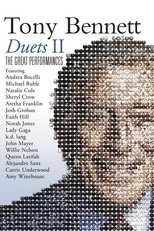The Smithsonian Institution’s National Museum of American History created Jazz Appreciation Month in 2001. Experience some of jazz’s greatest performers for yourself!
New Orleans
Putumayo provides a nice introduction to Nawlins jazz here, with a pretty good mix of the classic and the contemporary. The music remains, despite its era or performer, fully of the New Orleans style. The patron saint of the city, as well as the genr
Read More View in CatalogTrue Love: A Celebration of Cole Porter
Following his foray into the uber-contemporary pop production of 2015's That Would Be Me, Harry Connick, Jr. returns to his swinging big-band sound with 2019's True Love: A Celebration of Cole Porter. The singer's first album since sig
Read More View in CatalogBest of Preservation Hall Jazz Band
Opened in 1961 to preserve the rich and vibrant history of New Orleans Jazz, Preservation Hall, located in the city’s French Quarter, was one of the first venues to welcome both Caucasian and African-American musicians. Soon after the venue’s inv
Read More View in CatalogGershwin's World
Gershwin’s World is a tour de force for Herbie Hancock, transcending genre and label, and ranking among the finest recordings of his lengthy career. Released to coincide with the 100th anniversary of George Gershwin’s birth, this disc features ja
Read More View in CatalogKind of Blue
The best-selling jazz record of all time is a universally acknowledged masterpiece, revered as much by rock and classical music fans as by jazz lovers. The album is Miles Davis' Kind of Blue. Kind of Blue brought together seven now-legendary mus
Read More View in CatalogWomen of Jazz
As Putumayo builds its genre base to include a little more than its initial world pop, jazz appears to be one of the first targets on their continued march. Hearkening back to some of their older releases focusing on women, here the label collects a
Read More View in CatalogTurn Up the Quiet
Diana Krall spent the better part of the 2010s exploring byways of American song -- her 2012 set Glad Rag Doll drew heavily on obscure jazz from the 1920s and '30s, its 2015 sequel Wallflower concentrated on pop and rock tunes -- but 2017's
Read More View in CatalogThe Standard
There are two ways to interpret the title of the famed multiple Grammy- and Dove Award-winning vocal group's debut on Heads Up Records. First and most obviously, it's a reference to the way they have been setting high bars in the jazz and g
Read More View in CatalogNina Revisted...
Nina Revisited is attached to the documentary What Happened, Miss Simone?, a loving tribute itself, but also a painfully honest one. This possible soundtrack takes a more abstract route while offering the same love and reverence, and it's also a
Read More View in CatalogTheir Greatest Hits
Compiling all the major hits that legendary jazz alto saxophonist Stan Getz had with Brazilian songwriter and vocalist Antonio Carlos Jobim, Stan Getz/Antonio Carlos Jobim: Their Greatest Hits is a nice single-disc collection. While there are deeper
Read More View in CatalogEsperanza Spalding - Chamber Music Society
Spalding has assembled an intriguing collection of tunes, is accompanied by stellar backing musicians -- drummer Terri Lynne Carrington, pianist Leonardo Genovese, and percussionist Quintino Cinalli with a pair of string players -- and guests that re
Read More View in CatalogThelonious Monk Quartet with John Coltrane at Carnegie Hall
Larry Appelbaum, the recording lab supervisor at the Library of Congress, came across this tape by accident while transferring the library's tape archive to digital. What a find. Forget the Five Spot recording that sounds like it was recorded in
Read More View in CatalogBillie's Best
Towards the end of Billie's career, her once clear and energetic voice now reflected her internal struggles. But even her inner demons transformed into heavenly angels when she recorded for Verve in the mid-1950s. Includes Lady Day and small jaz
Read More View in CatalogDuke Ellington
Duke Ellington was one of the most important creative forces in the music of the twentieth century. His influence on classical music, popular music, and, of course, jazz, simply cannot be overstated.
View in CatalogThe Essential Charlie Parker
Another anthology that has less value due to the exploding reissue market. These cuts were among Parker's most influential compositions and performances, but they've been reissued many times, both in anthology packages and on re-releases of
Read More View in CatalogBest of the Big Bands
The Best of the Big Bands features the music of: Glenn Miller Orchestra; Duke Ellington; Benny Goodman Orchestra; Count Baise and Woodie Herman. Chatanooga choo choo (Glenn Miller Orchestra) -- Pennsylvania 6-5000 (Glenn Miller Orchestra) -- Woodchop
Read More View in CatalogThe Best of Miles Davis & John Coltrane
This compilation is taken from the masterful and wondrous box set issued late in the year 2000. It is assembled with the kind of care only producers such as Bob Belden and Michael Cuscuna could muster. Featuring nine selections, it begins with the fi
Read More View in CatalogLady Be Good: Instrumental Women In Jazz
Lady Be Good reveals the lost stories of female jazz musicians from the early 1920s to the 1970s. Narrated by musician-composer Patrice Rushen, the film charts the influence of female players from the struggles and successes of early innovators (Swee
Read More View in CatalogTony Bennett: Duets II - The Great Performances
Bennett again recorded his greatest hits with a celebrated list of artists and Duets II made music history by debuting top of the Billboard chart. Duets II: The Great Performances is a visually stunning accompaniment to the album, featuring full song
Read More View in Catalog

















